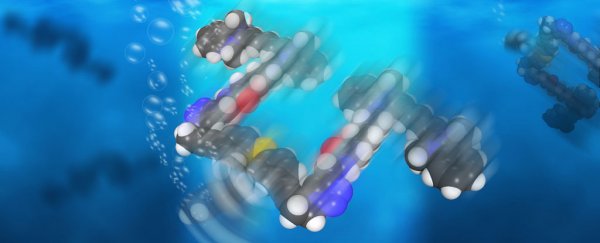In science-fiction movies like Fantastic Voyage and Innerspace, plucky individuals board microscopic submersibles and take a trip inside the human body… where predictably dramatic consequences ensue.
We're not quite there yet, but it seems we're getting close. Scientists in the US have developed nanosubmarines (aka. unimolecular submersible nanomachines) composed of a single molecule of just 244 atoms.
The nanosubs are powered by ultraviolet light, with the motor's tail-like propeller – which operates more like a bacteria's flagellum than a conventional motorised propeller – moving the nanomachines forward by 18 nanometres with each full revolution.
Now it's fair to say nobody will try to sell you an engine based on how quickly it goes from zero to 18 nanometres, and to be sure, that doesn't sound very far. But given the scale of the nanosub itself and the frequency of revolutions per minute (RPM), these are actually extremely fast little boats.
With a constant UV power source, the motor runs at more than a million RPM, rocketing the sub through solution at a top speed of 2.5 centimetres (1 inch) per second. Not too shabby, especially when you consider that the nanosubs have to make their way through solution crowded with moving molecules of similar size. Crosstown traffic, effectively.
"This is akin to a person walking across a basketball court with 1,000 people throwing basketballs at him," said chemist James Tour from Rice University. "These are the fastest-moving molecules ever seen in solution."
Tour's team has prior form with nanomachines. They developed nanocars a decade ago, and use a nano-scale motor designed by researchers in the Netherlands for their new submersibles.
"These motors are well-known and used for different things," said Victor García-López, lead author of the study. "But we were the first ones to propose they can be used to propel nanocars and now submersibles."
The nanosubs are made via a 20-step chemical synthesis. When placed in solution, the double bond that holds the rotor to the body becomes a single bond when excited by UV light, turning the propeller as long as the light stays on. They cannot as yet be steered or otherwise controlled, short of powering them down by negating the UV light.
When compared with nanosubs without the motor running, the motorised nanomachines showed an enhancement in diffusion of 26 percent (as against the rate of diffusion they'd already display thanks to Brownian motion). The findings are published in Nano Letters.
It's hoped that in the future nanosubs will be able to do more than simply diffuse at greater speed, with the researchers hinting that one day they may be able to ferry microscopic cargo like medicines – which makes it sound as if things like Fantastic Voyage and Innerspace aren't actually too far away after all.
"There's a path forward," said García-López. "This is the first step, and we've proven the concept. Now we need to explore opportunities and potential applications."
